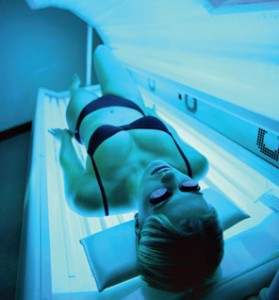The use of indoor tanning facilities and tanning beds has become popular over the years. Many individuals use tanning in preparation for a vacation in sunny climates, but an overwhelming number flocks to tanning booths in order to preserve this summer tan. Despite all cautioning from dermatologists, tanning salons have their steady clientele. While the occasional use may be no reason for alarm, steady usage sheds a different light on the”artifical sun”.
Tanning dependence has been found to be common in young adults, as a survey of 400 college student revealed. The behavior can be predicted by certain demographic and behavioral variables. Initially the motivation for tanning is the enhancement of appearance, but often those who use tanning facilities frequently report that it contributes to enhance their mood and help with relaxation and socializing. There was also a disregard for warnings about health risks of the practice. Dr. Carolyn Heckman, PhD of Fox Chase Cancer Center in Cheltenham,Pa. and her colleagues reported that these behaviors are commonly reported by individuals with other types of dependencies. In this respect excessive use of tanning has similarities to other behavioral disorders such as obsessive compulsive behavior and eating disorders, which has given it the nickname “tanorexia”.
The population profile showed that most of the tanning dependent individuals were female, and the highest group was white with a medium skin type, as opposed to fair and darker skinned individuals. Those who were doing the most sunbathing in summer and had the highest rates of sunburn also were the most tanning dependent. They were also the ones who used the least amount of sun protection. Smokers had the highest level of tanning dependence, whereas obese individuals had the lowest one. The highest proportion showed up in the female population. Males did not seem to be that interested in tanning.
The research is relevant for health professionals when it comes to teaching patients about skin cancer prevention and education about sun protection. It also points to possible relationships to other addictive disorders.
More information about skin cancer: http://nethealthbook.com/cancer-overview/skin-cancer/
References: 1. http://www.skincancer.org/content/view/317/78/ 2. Am. J. Health Behav. 2008;32:451-64
Last edited November 5, 2014






